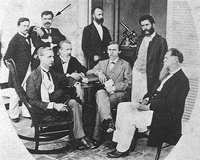|
The
Dawn of the 20th Century
In the years
from the Civil War until the dawn of the 20th century, profound
changes occurred in medicine. These changes were reflected
in events at both Charity and Tulane School of Medicine. In
1885, the first ambulance service at Charity began. At that
time third and fourth year Tulane medical students competed
via testing for a spot as an intern at Charity. Once made
an intern, the student had to live in the hospital, “subject
to call, day or night, to any of the duties assigned to him.”
Every eight days the intern was subject to 48 continuous hours
of ambulance duty. The tradition of using interns as Charity
ambulance physicians continued well into the 1960’s.
In one disturbing story, the ambulance took so long to arrive
on the scene of its first call that the ailing patient recovered
and had left. The intern, however, did not want to return
empty handed, so he and his driver forcibly took a young black
man back to Charity and claimed he was their patient. Nonetheless,
being chosen for the Charity Ambulance Corps was seen as a
great honor for interns.
It is easy to
forget how revolutionary the late 19th century was in the
history and development of medicine. Germ theory evolved around
this time. In 1881 Louis Pasteur had discovered that attenuated
cultures of bacteria could induce immunity. By 1897, Robert
Koch was making advances in steam sterilization, Joseph Lister
had successfully used carbonic acid to kill bacteria in wounds,
and the tubercle bacillus had been isolated. In 1896 Charity
received its first x-ray machine. In 1900 the Aedes aegypti
mosquito was identified as the vector for yellow fever via
the Reed Commission’s work.
 Rudolph
Matas, the father of vascular surgery, is one of Tulane’s
most illustrious graduates. Born in Louisiana to Spanish immigrants,
Matas matriculated at the University of Louisiana Medical
Department in 1878. In 1879, Matas, then a medical student,
accompanied then dean of Tulane Dr. Stanford Chaille to Cuba
to search for the cause of yellow fever. While they did not
identify a cause, they did take photomicrographs of tissue
obtained at autopsy. Using these photomicrographs, Cuban Dr.
Carlos Finlay was the first to suggest mosquitoes as vectors
of yellow fever, in 1881. Matas championed this idea but it
was not until 1900 and the work of the Reed Commission was
this theory proven. Matas won a coveted spot as an intern
at Charity, and in 1883 was appointed a demonstrator of anatomy
for the medical school. In 1885, at the age of 24, he published
his first landmark paper than defined the cecum and appendix
as intraperitoneal structures, rather than retroperitoneal
as had been assumed. In 1888, Matas performed the first successful
endoaneurysmal repair operation. In 1894 Matas was appointed
to the prestigious Chair of Surgery at Tulane. His list of
innovations continued: the first to perform surgery under
spinal anesthesia, among the first to perform a thyroidectomy,
the first to use intravenous fluids during surgery, and the
first use of intralaryngeal insufflation to prevent surgically
induced pneumothorax during chest surgery. Rudolph
Matas, the father of vascular surgery, is one of Tulane’s
most illustrious graduates. Born in Louisiana to Spanish immigrants,
Matas matriculated at the University of Louisiana Medical
Department in 1878. In 1879, Matas, then a medical student,
accompanied then dean of Tulane Dr. Stanford Chaille to Cuba
to search for the cause of yellow fever. While they did not
identify a cause, they did take photomicrographs of tissue
obtained at autopsy. Using these photomicrographs, Cuban Dr.
Carlos Finlay was the first to suggest mosquitoes as vectors
of yellow fever, in 1881. Matas championed this idea but it
was not until 1900 and the work of the Reed Commission was
this theory proven. Matas won a coveted spot as an intern
at Charity, and in 1883 was appointed a demonstrator of anatomy
for the medical school. In 1885, at the age of 24, he published
his first landmark paper than defined the cecum and appendix
as intraperitoneal structures, rather than retroperitoneal
as had been assumed. In 1888, Matas performed the first successful
endoaneurysmal repair operation. In 1894 Matas was appointed
to the prestigious Chair of Surgery at Tulane. His list of
innovations continued: the first to perform surgery under
spinal anesthesia, among the first to perform a thyroidectomy,
the first to use intravenous fluids during surgery, and the
first use of intralaryngeal insufflation to prevent surgically
induced pneumothorax during chest surgery.
At the same
time, medical education was lagging behind. A watershed moment
in the history of medical education was the publication of
the Flexner report in 1910. This report studied 155 American
and Canadian medical schools and found 75% of them were wholly
inadequate in terms of teaching future physicians. Tulane,
however, was ranked among the top three Southern medical schools,
along with Vanderbilt and the University of Texas, and among
the top seven schools nationally.
Medical students
continued to play important roles for health in the city.
In 1914, a Swedish sailor and his roommate were discovered
to have bubonic plague. Hysteria ensued in the city, with
widespread fear of rats and the spread of plague. In response
to this, city officials organized teams of rat patrols made
up of Tulane medical students. These teams were sent throughout
the slums of the city, filling garbage cans with dead rats
and dissecting and culturing lymph nodes for evidence of the
plague bacillus. It was claimed Tulane medical students were
thanked for killing “nearly one-fourth of the total
rodent population of New Orleans.”
prev | 1
| 2 | 3
| 4 | 5
| 6 | 7
| 8 | 9
| next |


